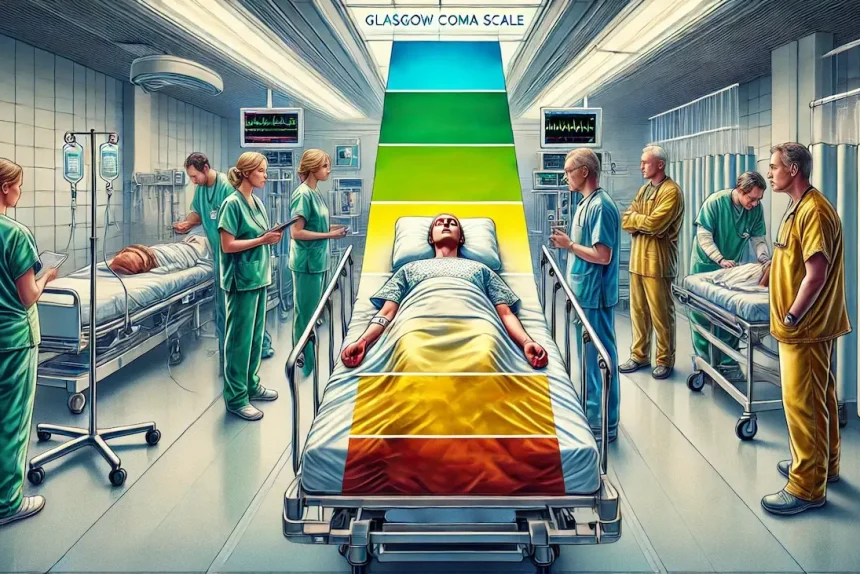Welcome to our comprehensive guide on the Glasgow Coma Scale (GCS), an essential tool for clinicians in assessing brain injury severity. Understanding the GCS is crucial for both patients and healthcare professionals as it evaluates consciousness in brain-injured patients. This guide explores the scale’s components and occupational therapy treatments based on GCS scores.
Understanding the GCS and Its Importance
The Glasgow Coma Scale (GCS) is extensively used to gauge the level of consciousness impairment in patients with brain injuries. It evaluates three aspects: Eye Opening Response, Best Verbal Response, and Best Motor Response, each contributing to a total score between 3 and 15.
Components of the Glasgow Coma Scale
- Eye Opening Response (E): Measures reactions from spontaneous to no response.
- Best Verbal Response (V): Ranges from oriented conversation to no verbal response.
- Best Motor Response (M): Assesses reactions from obeying commands to no motor response.
Total Score Interpretation: A score below 8 indicates a severe injury, while 9-12 denotes moderate injury, and 13-15 implies mild or no injury.
Here’s a breakdown of how occupational therapy treatments align with the Glasgow score:
Actionable Therapies Based on GCS Scores
- Severe Injury (Score < 8): Engage in passive range of motion and sensory stimulation activities.
- Moderate Injury (Score 9-12): Focus on assisted motor activities and simple cognitive tasks using cues.
- Mild Injury (Score 13-15): Implement active motor activities and higher-level cognitive tasks.
Regular practice on these therapy activities can enhance recovery. In our full guide, you will find detailed case examples and quizzes to strengthen your understanding.
GCS Scale Posturing Highlights
Patients may exhibit decorticate or decerebrate posturing based on their motor response scores:
- Decorticate Posturing: Arms flexed and feet turned inward, rating 3 on GCS.
- Decerebrate Posturing: Arms extended and internally rotated, rating 2 on GCS.
Remember to utilize mnemonics to differentiate postures: ‘COR’ for Decorticate (arms to core) and emphasis on ‘E’s’ for Decerebrate (extensions).
Comparing Decorticate vs Decerebrate Posturing
A brief preview reveals that decorticate posture suggests cerebral hemisphere lesions, while decerebrate posturing indicates more serious brainstem issues. To understand fully, dive into our member content for in-depth explanations.
Interactive Question
Can you identify which posturing (decorticate or decerebrate) indicates a more severe brainstem lesion?
These insights will aid your preparation for the NBCOT® exam, ensuring you grasp the complexities of the Glasgow Coma Scale and its implications in clinical practice.
Want detailed practice tips to ace the NBCOT® exam? Join now for full access!
What is the Glasgow Coma Scale and why is it important?
The Glasgow Coma Scale (GCS) is a clinical tool used to assess consciousness in patients with brain injuries. It measures eye opening, verbal, and motor responses to determine the severity of a brain injury, which can range from mild to severe. Understanding GCS is crucial for effective evaluation and treatment planning.
How are Glasgow Coma Scale scores interpreted?
GCS scores range from 3 to 15. A score below 8 indicates a severe brain injury, scores between 9 and 12 suggest a moderate injury, and scores from 13 to 15 imply mild or no brain injury.
What occupational therapy treatments are recommended based on GCS scores?
For severe injuries (GCS < 8), passive range of motion and sensory stimulation are advised. Moderate injuries (GCS 9-12) benefit from assisted motor activities and simple cognitive tasks. Mild injuries (GCS 13-15) should focus on active motor activities and higher-level cognitive tasks.
What is the difference between decorticate and decerebrate posturing?
Decorticate posturing, rated 3 on the GCS, involves arms flexed and feet turned inward, indicating cerebral hemisphere lesions. Decerebrate posturing, rated 2 on the GCS, is characterized by arms extended and internally rotated, suggesting more serious brainstem issues.
How can I effectively prepare for the NBCOT® exam using GCS information?
Understanding the Glasgow Coma Scale and its clinical implications is key for the NBCOT® exam. Engaging with interactive content, mnemonics, and case examples can enhance your comprehension and exam readiness. For detailed resources, consider joining specialized programs offering practice tips and content.



